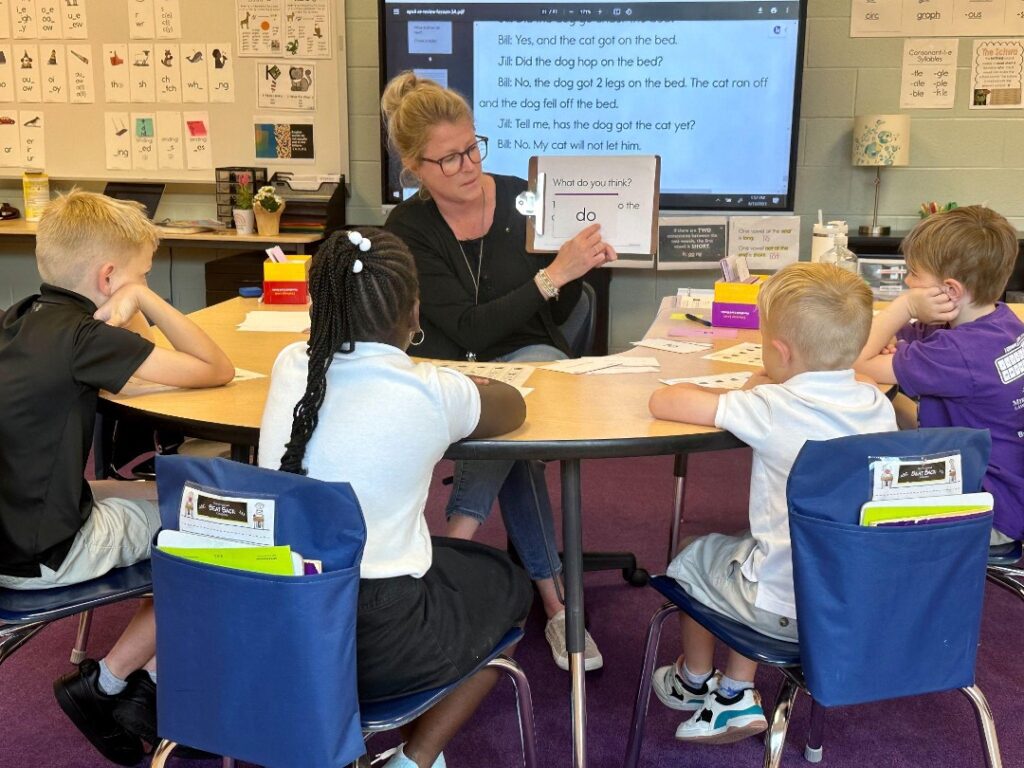In January 2023, the South Carolina State Board of Education approved new standards for English Language Arts instruction. While the standards will not be assessed until spring 2025, schools and districts have begun digging into the kinds of shifts the new standards will require. These new standards mark a momentous change in the way South Carolina is requiring educators to implement evidence-based literacy instruction.
To help understand the new standards, schools and districts have begun engaging in a variety of science of reading professional learning training courses such as LETRS and the Online Elementary Reading Academy (OERA).
According to Dr. Louisa Moats, nationally recognized researcher and developer of the LETRS training program, science of reading-based professional learning helps “develop critical consumers that have a better sense of what they should be looking for in an evidence-based literacy program and how they might keenly identify a program’s deficits in serving early readers.”
In this interview, Scarlett Mooney, literacy leader in Beaufort County, South Carolina, shares her insights about how her school, River Ridge Academy, has begun shifting its practices to align with the SC CCR ELA Standards.

As a curriculum leader, what were some of your initial thoughts when you first read the new South Carolina standards for ELA instruction?
For as long as I can remember, our ELA standards have been broad and sweeping, following the general theory of “a mile wide and an inch deep.”
The 2015 South Carolina CCR ELA Standards focused on inquiry based literacy instruction rather than approaching teaching and learning in a systematic and explicit method. Those standards also lacked specificity, allowing educators to interpret the meaning and intent behind the standards.
Simply put, there wasn’t enough clarity, guidance, or support to fully understand what students should know and be able to do at each grade level.
As I read the new 2023 SC CCR ELA Standards, I immediately noticed how specific the new standards are and how supportive the document is for educators. The new ELA standards include “Indicator Insights” that give clear guidance on the expectation of each standard. The standards also provide South Carolina educators consistent language for teaching academic vocabulary, eliminating the potential for interpretation and misunderstandings.
The new South Carolina ELA standards are supported by research that clearly follows the science of reading.
The new South Carolina ELA standards are supported by research that clearly follows the science of reading. The vertical progression is detailed, with clear expectations for what students should learn at each grade level.
You can see the systemic approach embedded throughout the progression of Kindergarten through English 4, with a depth of knowledge and clear understanding.
Over all, the new standards are clear, measurable, and demonstrate a progression across grade levels that follows the science behind teaching students how to read.
How might you say South Carolina standards’ six essential foundations align with River Ridge Academy’s implementation of the SIPPS (Systematic Intervention Phonics, Phonological Awareness and Sight Words) program?
I can’t begin to express how excited I am to see research, theory, and practice all align. Throughout my career as an instructional leader, the goal has always been to ensure our instructional practices align to research that best supports learning.
Sometimes it’s easy to unintentionally get caught up in practices that are not supportive of essential foundational skill development, resulting in subpar academic gains. For years, these practices have left us wondering why our young readers and writers aren’t growing and learning as expected.
The alignment between Scarborough’s Reading Rope, the new 2023 standards, and SIPPS is the complete package.
The alignment between Scarborough’s Reading Rope, the new 2023 standards, and SIPPS is the complete package. The new state standards include all the essential components to develop those foundational reading skills supported by research.
SIPPS provides educators with the instructional routines and content that support the implementation of the new standards. Allow me to explain in more depth, with specificity, just how SIPPS supports the teaching of the new 2023 standards.
The SIPPS scope and sequence begins in the simple alphabetic stage and progresses all the way through the complex polysyllabic/morphemic stages of word recognition. In the 2023 standards, kindergarten students are expected to blend letter sounds to decode vowel-consonant and vowel-consonant-vowel words in isolation and in text (ELA.K.F.3.5). This standard develops across each step of a SIPPS Beginning Lesson, which includes: Phonological Awareness, Phonics/Decodable Words, Sight Words, Reading A Story, and finally, Guided Spelling.
I appreciate the final application steps of each lesson as they ensure students apply their new learning by reading connected text every day. The systematic scope and sequence coupled with explicit instructional routines found throughout each and every SIPPS lesson support all students with those early foundational literacy skills.
The systematic scope and sequence coupled with explicit instructional routines found throughout each and every SIPPS lesson support all students with those early foundational literacy skills.
When thinking about instructional routines, SIPPS instruction is based on four guiding principles. Instruction is clear, concise, consistent, and choral. When our teachers first implemented SIPPS, it was hard to minimize the teacher talk and need to explain things to students.
We have learned along the way to remove the unnecessary information and keep our instruction aligned with the four principles. When we became really good at keeping our instruction clear, concise, consistent, and choral, we observed students learning at a much quicker pace. Honestly, we had to learn how to not “overteach it” to eliminate confusion and keep our instruction clear.

Another critical component in the instructional routines is that the choral responses lead to 100 percent engagement 100 percent of the time.
I often describe the instructional routines as a dance. Dance partners must move interdependently as a unit. They are responsible for their own steps and skill development, but perform as a group of dancers led by an instructor. The corrective feedback and cueing is immediate, with modeling and support for students to demonstrate their learning.
SIPPS provides targeted instruction in a manner that allows students to learn to read while aligning with research and the implementation of our new standards.
River Ridge Academy has implemented SIPPS over the past two years. In what ways has implementing this evidence-based program helped you and your teachers approach the goals of the new standards?
We actually began implementing SIPPS in 2019 as an intervention tool with the goal of increasing student achievement in our most struggling readers. Our RTI/MTSS model was upside down, and our teachers were identifying more and more students for literacy intervention.
Each year with SIPPS, we saw firsthand the growth in reading, even in the upper elementary grades. Our students were gaining more than confidence and they were gaining the necessary skills to be readers—the ultimate goal.
Each year with SIPPS, we saw firsthand the growth in reading, even in the upper elementary grades. Our students were gaining more than confidence and they were gaining the necessary skills to be readers—the ultimate goal.
In the aftermath of school closures in 2020, we found intervention wasn’t enough to address the needs and acted with a sense of urgency. Over the past two years, we have implemented SIPPS at all tiers of instruction.
We shifted our thinking from teaching students to read leveled text and reach a certain goal by the end of the grade level to thinking about our systems and processes within our school that either helped or hindered us in reaching all students. When we began thinking about our systems and started to develop processes, our lens shifted and we gained a new perspective on teaching and learning.
SIPPS gave us the process with explicit instructional routines to ensure high quality literacy instruction that aligned to research.
SIPPS gave us the process with explicit instructional routines to ensure high quality literacy instruction that aligned to research. Because of the work we have embraced over the past four years with implementing SIPPS, the transition to the new standards will be seamless as it aligns with the work we have been doing.
The new standards support systematic and explicit instruction for those foundational reading skills in ways the old standards did not. It’s really exciting to see our new ELA standards align with research and support the systems we have established.
What advice would you give to schools who are considering pairing the SIPPS program with new standards?
All educators are on a new journey together learning the science of reading and the systematic changes that must take place. Our new ELA standards are one example of systematic change at the state level.
If you are considering SIPPS, I would encourage you to take the leap and trust the process. Your commitment to the process will determine your progress. Be committed. We have seen firsthand the success with implementing SIPPS in grades K–5.
I would also encourage your instructional leadership team to reflect on the current systems and processes you have in place that support the new standards. Analyze your current systems. Do they move students closer to the goal of being skilled readers? When implementing SIPPS, you don’t need to complete a whole science of reading course of professional learning to implement the evidence-based instructional routines. SIPPS provides teachers with the support they need to effectively implement the program with students starting on the first day of school.
***
Related:
Learn more about SIPPS.
Read How One South Carolina School Uses SIPPS for Immediate Intensive Intervention.
Read about how North Carolina Teachers Combine Best Practice with SIPPS.
